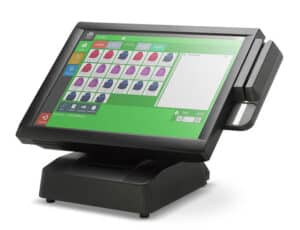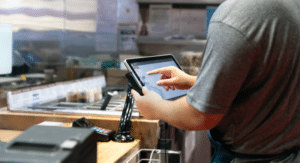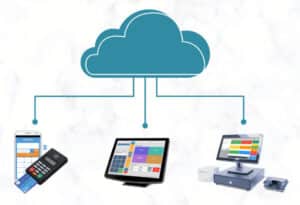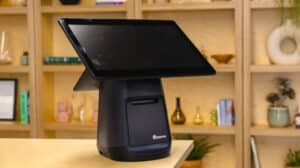How to Choose a Cloud EPOS for Your Restaurant
Choosing the right cloud EPOS (Electronic Point of Sale) system for your restaurant is an important decision with the potential to impact your operations, customer experience, and bottom line.
Having a reliable, flexible, and scalable EPOS system is key to streamlining orders, managing payments accurately, tracking and maintaining inventory, and more.
But with so many options available, making the best choice for your restaurant can be overwhelming.
We’ll walk you through the key factors to mull over when choosing a cloud EPOS to ensure it meets your unique needs and supports your business growth.
How to Pick A Restaurant Cloud EPOS
- Examine the Key Features
- Consider Your Restaurant’s Size and Needs
- Think About Integrations
- Review The Pricing Structure
- Look for Good Customer Support and Training
1. Key Features to Look for in a Cloud EPOS

Selecting a cloud EPOS with the features you need can greatly improve efficiency, optimise service, and boost profitability.
These are the essential features you’ll want from any cloud EPOS system:
1. Ease of Use
An intuitive interface is crucial for both front-of-house staff and managers.
You’ll need a user-friendly interface that minimises the learning curve for new employees. Quick, accessible navigation helps staff take orders , process payments, and manage tables easily, reducing errors and wait times.
A system that simplifies your staff’s tasks should lead to faster service, more customer satisfaction, and a smoother experience overall.
The system should offer clear access to data analytics, menu management, employee performance metrics, and sales reports without extensive technical knowledge.
2. Order Management
Order management is a core function of any restaurant EPOS, and it’s important to choose one that handles dine-in, takeaway, and delivery seamlessly.
An efficient cloud based POS system should let staff quickly send orders to the kitchen, split bills for customers, and handle both visits and online orders from third-party platforms like UberEats.
Advanced order management features might include real-time order tracking and alerts to prevent errors and reduce delays, helping you serve your customers faster and more accurately.
3. Payment Integration
Restaurant EPOS systems should support a wide variety of payment methods, including contactless cards, mobile wallets, and digital payment platforms. A smooth, secure checkout process assists the customer experience and reduces bottlenecks during peak hours.
The system should also support split payments and automatic tips, making it easier for groups to settle their bills and for servers to receive gratuities. Integrating multiple payment gateways ensures flexibility and keeps transactions efficient.
4. Inventory Management
Accurate inventory management can prevent food waste and keep your restaurant running smoothly.
POS systems with robust inventory tracking let you to monitor stock levels in real-time, automatically deducting items from inventory as they’re ordered. This feature helps prevent over-ordering or running out of popular menu items, which can negatively impact customer satisfaction.
Some systems offer low-stock alerts, letting you know when to reorder, and detailed reports that identify best-selling items and reduce waste.
This kind of inventory management insight can help control costs and improve profit margins.
5. Table Management
Efficient table management can maximise seating capacity and facilitate a smooth flow of customers.
Built-in table management tools allows hosts and servers to assign tables, manage reservations, and optimise seating arrangements in real-time. This can greatly improve turnover by helping staff manage busy periods and avoid double-bookings.
More advanced systems might include a digital floor plan of your restaurant, allowing you to view table occupancy at a glance.
6. Customer Loyalty and Marketing Features
Building customer loyalty is crucial for repeat business, and POS systems with integrated CRM (Customer Relationship Management) and marketing features can help drive this.
Look for systems that offer loyalty programs, allowing you to reward regular customers with points or discounts. These features help build a connection with your customers and encourage them to return.
Marketing tools that allow you to segment your customer base and send targeted promotions via email or SMS are another great tool for increasing engagement.
7. Staff Management
A cloud EPOS system with integrated staff management features can simplify team management.
Opt for a system that lets you schedule shifts, manage employee timesheets, and track attendance. This streamlines payroll management and guarantees accurate clock-ins and outs.
Performance tracking tools are also valuable.
For example, you can monitor which employees are processing the most orders or generating the highest sales, helping you identify top performers and make informed staffing decisions.
2. Choosing a System That Fits Your Restaurant’s Size and Needs

The ideal point of sale should align with your restaurant’s size and specific requirements to maximise efficiency and keep costs in check.
Different types of restaurants, from small independents to large franchises, have varying operational needs, so it’s important to choose a system that suits your business model.
Small, Independent Restaurants
If you’re running a smaller business, cost-effective solutions are likely a priority.
You’ll want a system that offers essential features without overwhelming you with advanced options that you might not need. Look for a restaurant EPOS system that offers flexible pricing plans, ideally with lower upfront costs or pay-as-you-go subscriptions.
Some considerations may include:
- Simplicity: Choose an intuitive system with straightforward features that are easy to set up and manage without requiring extensive technical support.
- Core Features: Ensure that the EPOS covers basic functions like order management, payment processing, and inventory tracking, but doesn’t charge extra for features you won’t use.
- Scalability: Choosing a system that can grow with your business is essential. Make sure the provider offers the ability to add features or upgrade your plan as your restaurant expands.
- Customer Support: 24/7 support is important to resolve issues quickly and keep your hospitality businesses running smoothly.
Franchises and Multi-location Restaurants
Here, scalability and central management are crucial.
You’ll need a cloud EPOS system capable of handling multiple outlets while providing a centralised hub for managing your entire operation.
A few key factors include:
- Centralised Reporting: Your EPOS should consolidate sales, inventory, and employee performance data across multiple locations. This allows for real-time oversight and helps managers make data-driven decisions for each outlet.
- Scalability: This is crucial for future expansion. Ensure the EPOS can easily add new locations and handle increased transaction volumes without a drop in performance.
- Customisable Menus and Pricing: The ability to customise menus and pricing by location is key. Choose a system that allows for menu variations and regional pricing while maintaining centralised control.
- Employee Management Across Locations: Integrated staff scheduling and time tracking tools that work across all outlets are essential for keeping labour costs in check and maintaining consistency in employee management.
- Multi-location Order Management: Whether for delivery, dine-in, or takeout, your EPOS should seamlessly coordinate orders across different branches, allowing for smooth communication between the front-of-house and kitchen in each location.
3. Integration with Other Systems

Whether it’s communication between the waitstaff and kitchen or syncing sales data with accounting platforms, seamless integration can boost efficiency and streamline workflows.
Here are some critical integrations to consider:
POS Integration with Kitchen Display Systems (KDS)
Smooth communication between the front-of-house staff and kitchen is vital for getting orders prepared accurately and on time.
A cloud EPOS that integrates with a Kitchen Display System (KDS) enables real-time order tracking and minimises manual errors.
- Improved Order Accuracy: Orders placed at EPOS systems are instantly sent to the KDS, reducing the chances of miscommunication or missed orders. This is particularly useful during busy periods, where human error can really disrupt service.
- Faster Service: The integration allows for real-time updates on order status, helping waitstaff manage customer expectations and improve service speed. Additionally, colour-coded indicators can show order progress, helping you provide timely service.
- Reduced Waste: By minimising manual errors, fewer incorrect orders are prepared, leading to less food wastage and lower costs.
Integration with Accounting Software
Keeping track of your restaurant’s finances is easier when your system integrates with accounting platforms like Xero, QuickBooks, or Sage.
This integration automates the flow of sales data from your EPOS into your accounting software, saving time and reducing the potential for human error.
- Automated Data Entry: Instead of manually inputting daily sales figures, an integrated system automatically transfers sales data, taxes, and expenses to your accounting platform. This saves time and reduces the risk of errors during data entry.
- Real-Time Financial Reporting: With real-time data synchronisation, restaurants can generate up-to-date financial reports to track revenue, profits, and expenses. This allows for better financial decision-making, such as controlling food costs or labour expenses.
- Simplified Payroll and Tax Management: For restaurants with integrated staff management features, payroll data can also be synced with accounting software. This ensures accurate wage calculations and tax filings, helping you stay compliant with local tax regulations.
Third-party Delivery Integration
With the growing popularity of food delivery services, integrating your cloud EPOS with third-party delivery platforms is essential.
This integration helps streamline the management of online orders, ensuring they are processed efficiently without disrupting your in-house operations.
- Centralised Order Management: An integrated system brings all online orders from multiple delivery platforms into a single interface. This allows staff to manage orders from different platforms without juggling multiple devices or apps, reducing the chance of errors.
- Real-time Menu Syncing: Any changes made to your menu, such as pricing updates or item availability, are automatically synced with delivery platforms. This prevents customers from ordering items that are out of stock or incorrectly priced.
- Improved Customer Satisfaction: By reducing order errors and speeding up the process from online order to kitchen preparation, you can enhance the delivery experience, ensuring that customers receive their meals accurately and on time.
4. Cost Considerations

When investing in a restaurant EPOS, understanding the cost structure is essential to making an informed decision. The costs associated with an EPOS system go beyond just the initial setup; ongoing fees and the long-term return on investment (ROI) should also be factored into your decision.
Here’s a breakdown of the primary cost considerations:
Initial Setup Costs vs. Ongoing Fees
One of the most important financial considerations is the difference between upfront setup costs and recurring fees.
POS system providers typically offer subscription-based pricing models, but there may also be additional one-time expenses.
- Initial Setup Costs: These may include the cost of hardware, installation, and any one-off customisation fees. Some offer hardware bundles, while others require you to purchase equipment separately. Installation fees may also apply, particularly if you need help setting up your system.
- Subscription-based Pricing: Most EPOS systems charge monthly or yearly subscription fees. These cover the use of the software, cloud storage for your data, and ongoing support. Subscription costs can vary depending on the number of features included, the number of locations, or the number of users.
- Transaction Fees: Some providers charge a transaction fee on each sale, particularly if you’re using their payment processing services. These can add up, especially in high-volume restaurants, so it’s worth checking the rates and comparing them with third-party payment processors.
- Additional Costs: Other potential expenses might include integrations with third-party software, training for your staff, and any additional licences for extra features like customer loyalty programs.
Long-term ROI
While the initial investment in a cloud EPOS system may seem substantial, the right system can provide significant cost savings and operational efficiencies over time.
Here are some ways in which an EPOS can deliver long-term ROI:
- Reduced Errors: Automated processes like order and inventory tracking help minimise human errors, reducing incorrect orders and food waste. This not only cuts down on operational costs but also improves customer satisfaction, which can lead to repeat business.
- Time Savings: By automating manual tasks like data entry, report generation, and inventory updates, your staff can focus on customer service and improving the guest experience. This time-saving translates into higher productivity and smoother operations.
- Increased Sales: Features like customer loyalty programs and targeted marketing can drive repeat business and encourage upselling. An EPOS system that tracks customer preferences and behaviour allows for personalised promotions that lead to increased sales.
- Better Staff Management: EPOS systems with integrated staff scheduling and performance tracking can optimise labour costs by ensuring proper shift coverage without overstaffing. Additionally, performance reports help identify top performers, allowing for more efficient reward systems that boost productivity.
- Data-driven Decision Making: Access to real-time data allows you to make informed decisions about menu changes, pricing strategies, and staffing needs. With clear insights into your restaurant’s performance, you can identify trends, adjust inventory to avoid overstocking, and streamline operations to improve overall profitability.
5. Customer Support and Training

Effective customer support and staff training are critical when implementing a cloud EPOS system.
Since your EPOS will be at the heart of your operations, any technical issues or disruptions can severely impact your business, especially during busy periods.
Additionally, the ease with which your staff can adapt to the system will influence how smoothly it integrates into your daily operations.
Here’s why these aspects matter:
24/7 Support Availability
Having access to 24/7 customer support ensures that any problems with your cloud EPOS system are resolved quickly, minimising downtime and the risk of lost sales.
- Minimising Disruptions: When a technical glitch arises, especially during peak service hours, you need to know that support is available immediately. Around-the-clock support means that help is available when you need it most, reducing the risk of system outages or operational disruptions.
- Expert Assistance: Ensure that your provider offers access to knowledgeable, well-trained support staff who can quickly diagnose and resolve issues, whether it’s related to hardware, software, or integrations.
- Multiple Support Channels: Look for providers that offer various ways to contact support, including phone, email, live chat, or an online help centre. This flexibility allows you to choose the best method for getting assistance based on the urgency of the issue.
Onboarding and Staff Training
The success of any new EPOS system depends on how easily your staff can learn and adopt it.
Look for providers that offer extensive onboarding and training resources to ensure a smooth transition.
- Easy Onboarding Process: Your provider should offer a clear and efficient onboarding process, including system setup, menu configuration, and integrations. Some providers may offer personalised onboarding assistance, guiding you through the initial setup.
- Training for All Levels: It’s important that both front-line staff and management understand how to use the system effectively. Look for providers that offer multiple training resources to get your staff up to speed and feel confident using the system.
- Ongoing Learning: Beyond the initial training, your provider should offer ongoing learning opportunities to help your team master advanced features over time. This is particularly important as new updates and features are released. Some providers offer online knowledge bases or help centres where you can access guides and troubleshooting tips.
- Multi-language and Location-specific Training: If you operate a multi-location or international restaurant chain, consider whether the EPOS provider offers location-specific training that takes into account local regulations, languages, or currencies.
Conclusion
Choosing the right cloud EPOS system for your restaurant can have a lasting impact on your operational efficiency, customer satisfaction, and overall business growth.
By carefully reviewing key features like ease of use, order management, and payment integration, and ensuring the system fits your restaurant’s size and needs, you can make an informed choice that supports your specific goals.
For a trusted partner in finding the right EPOS for your business, contact NFS Hospitality.




